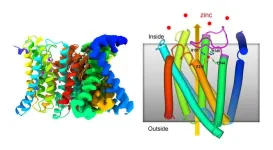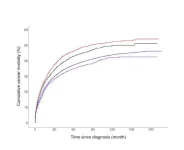(Press-News.org) Alexandra Hanlon, director of the Virginia Tech Center for Biostatistics and Health Data Science, was recently awarded a $1.25 million grant from the National Institutes of Health (NIH) for a summer program aimed at promoting and diversifying the field of collaborative biostatistics.
The Collaborative Undergraduate Biostatistics Experience (CUBE), an eight-week summer program geared toward underrepresented undergraduate students, will receive $250,000 per year over the next five years through the NIH Research Education Program.
This R25 award, which is funded in a joint effort from the National Institute on Drug Abuse and the National Institute on Alcohol Abuse and Alcoholism, is specifically targeted toward enhancing data science research training in addiction research.
CUBE, which was piloted in the summer of 2022 and highlighted in the April 2023 edition of Amstat News, is built on four pillars: training in introductory biostatistics, training in R programming, professional development, and a collaborative research project addressing research questions in various disciplines.
“There’s no program like this in the country – not even close,” said Hanlon. “There are summer programs in biostatistics, but none like ours that heavily emphasize professional development, including communication and technical writing; the technical aspects of R programming delivered in tandem with the corresponding biostatistics training modules; and an interactive collaborative research project that includes the mentorship of a clinical investigator.”
This year’s program — which is also funded by the integrated Translational Health Research Institute of Virginia, Merck, and Virginia Tech’s Fralin Life Sciences Institute and Institute for Society, Culture, and Environment — runs from June 5-July 28.
In addition to earning a $4,800 stipend, students enrolled in CUBE are provided with free housing. They are also afforded the opportunity to work closely with experienced collaborative biostatisticians, leading experts in the areas of addiction, and peer and graduate student mentors as they learn about the challenges of communicating and working collaboratively in a multidisciplinary team science environment.
Through CUBE, underrepresented undergraduate students receive an introduction to the world of collaborative biostatistics, opening up career pathways that they never knew existed. After participating in the CUBE pilot program in 2022, Kayla Williams, a recent graduate of Ohio State University, now plans to pursue her Ph.D. in biostatistics at Drexel University this fall.
“We need diversification in collaborative biostatistics,” Hanlon said. “The number of students in STEM continues to grow, but the percentage of underrepresented students remains very low.”
While the pilot program included just four students — two housed at Virginia Tech and two at the University of Virginia — and this year’s group features five students, the funding from this NIH grant will allow CUBE to expand to 10 students hosted at Virginia Tech each summer through 2027.
Still, Hanlon would like the program to grow even further to continue to raise awareness of collaborative biostatistics and diversity in the field. The ultimate goal is to expand the program nationally through multiple funding institutions across the country with centralized resources at Virginia Tech.
“We want to sustain CUBE for a long, long time,” said Hanlon.
END
Program for underrepresented undergraduate students in STEM receives NIH funding
2023-06-09
ELSE PRESS RELEASES FROM THIS DATE:
USTC enhances fluorescence brightness of single silicon carbide spin color centers
2023-06-09
In a study published online in Nano Letters, the team led by Prof. LI Chuanfeng and Dr. XU Jinshi from the University of Science and Technology of China of the Chinese Academy of Sciences made progress in enhancing the fluorescence of single silicon carbide spin defects. The researchers leveraged surface plasmons to markedly boost the fluorescence brightness of single silicon carbide double vacancy PL6 color centers, leading to an improvement in the efficiency of spin control using the properties of co-planar waveguides. This low-cost method neither calls for complex micro-nano processing ...
Researchers determine quantitative composition of ultrahigh-pressure fluid in deep subduction zones
2023-06-09
In a study published in PNAS, Prof. XIAO Yilin’s group from the University of Science and Technology of China (USTC) of the Chinese Academy of Sciences (CAS) quantitatively determined, for the first time, the chemical composition of supercritical fluids in deep subduction zones, through 3D imaging modelling of ultrahigh-pressure (UHP) multiphase fluid inclusions, and revealed the important role of supercritical fluids in the cycling of carbon and sulfur in subduction zones, which is of great importance ...
USTC reveals reconfiguration process of solar eruptions
2023-06-09
Recently, a research team led by Prof. GOU Yanyu from the University of Science and Technology of China (USTC) of the Chinese Academy of Sciences (CAS) found that the solar outburst structure undergoes a complex reconfiguration evolution during the early outbursts, thus making important advances in the study of solar outburst activity. This study was published in Nature Astronomy.
In classical images, the core structure of a solar eruption is a magnetic rope consisted of spirally wound magnetic lines. When the eruption begins, the magnetic ropes around the core are transformed by magnetic reconnection ...
DNA facilitates escape from metastability
2023-06-09
Prof. LIANG Haojun from the University of Science and Technology of China (USTC) of the Chinese Academy of Sciences (CAS) proposed a new method to escape from metastability for self-assembly in a far-from-equilibrium system. The study was published in PNAS.
Self-assembly refers to the process in which assembled primitive elements (molecules, nanoparticles, etc.) spontaneously form ordered structures through non-covalent interactions. Its excellent capacity to create new materials has drawn attention. In an ...
Single quantum bit achieves complex systems modeling
2023-06-09
A team led by Academician GUO Guangcan from the University of Science and Technology of China (USTC) of the Chinese Academy of Sciences (CAS), with collaborative efforts from the University of Manchester, and Nanyang Technological University, has achieved new progress in applying quantum technologies in complex systems modeling. The results were published in Nature Communications on May 6.
Stochastic modeling can help us to predict the future behavior of complex processes, which are non-Markovian. In order to simulate a non-Markovian process, a memory is of necessity to store a large amount of observed information about the past of the system. However, ...
Zinc transporter has built-in self-regulating sensor
2023-06-09
UPTON, NY — Scientists at the U.S. Department of Energy’s (DOE) Brookhaven National Laboratory have determined the atomic-level structure of a zinc-transporter protein, a molecular machine that regulates levels of this crucial trace metal micronutrient inside cells. As described in a paper just published in Nature Communications, the structure reveals how the cellular membrane protein shifts its shape to move zinc from the environment into a cell, and temporarily blocks this action automatically when zinc levels inside the cell get too high.
“Zinc is important for many biological ...
New model offers a way to speed up drug discovery
2023-06-09
CAMBRIDGE, MA — Huge libraries of drug compounds may hold potential treatments for a variety of diseases, such as cancer or heart disease. Ideally, scientists would like to experimentally test each of these compounds against all possible targets, but doing that kind of screen is prohibitively time-consuming.
In recent years, researchers have begun using computational methods to screen those libraries in hopes of speeding up drug discovery. However, many of those methods also take a long time, as most of them calculate each target protein’s ...
Black, Hispanic survivors of breast cancer have higher death rates from second cancers
2023-06-09
Hispanic and non-Hispanic Black female survivors of breast cancer experience higher death rates after being diagnosed with a second primary cancer than members of other ethnic and racial groups, according to recent research from investigators at the Johns Hopkins Kimmel Cancer Center.
In a study of nearly 40,000 adult survivors of breast cancer, the risk of death from a second cancer was 12% higher among non-Hispanic Black survivors and 8% higher among Hispanic survivors compared with non-Hispanic white survivors. Survivors in racial and ethnic minorities were diagnosed with second cancers ...
Mouse models of adolescent binge drinking reveal key long-lasting brain changes
2023-06-09
UNIVERSITY PARK, Pa — Heavy alcohol consumption may cause permanent dysregulation of neurons, or brain cells, in adolescents, according to a new study in mice. The findings suggest that exposure to binge-levels of alcohol during adolescence, when the brain is still developing, lead to long-lasting changes in the brain’s ability to signal and communicate — potentially setting the stage for long-term behavioral changes and hinting towards the mechanisms of alcohol-induced cognitive changes in humans.
“What we’re seeing here,” said Nikki Crowley, assistant professor in biology and biomedical engineering ...
Infants and toddlers up to 5 years old can participate in Shape Up! Keiki study at Pennington Biomedical
2023-06-09
The Pennington Biomedical Research Center is looking for children 5 years old and younger to participate in the Shape Up! Keiki research study. The purpose of the Shape Up! Keiki research study is to create a better way to measure and describe health from body shape.
“Parents can learn more about their child’s health by joining the Shape Up! Keiki study, while also providing important information that will help us find quick ways to measure obesity status and health based on a child’s body ...




